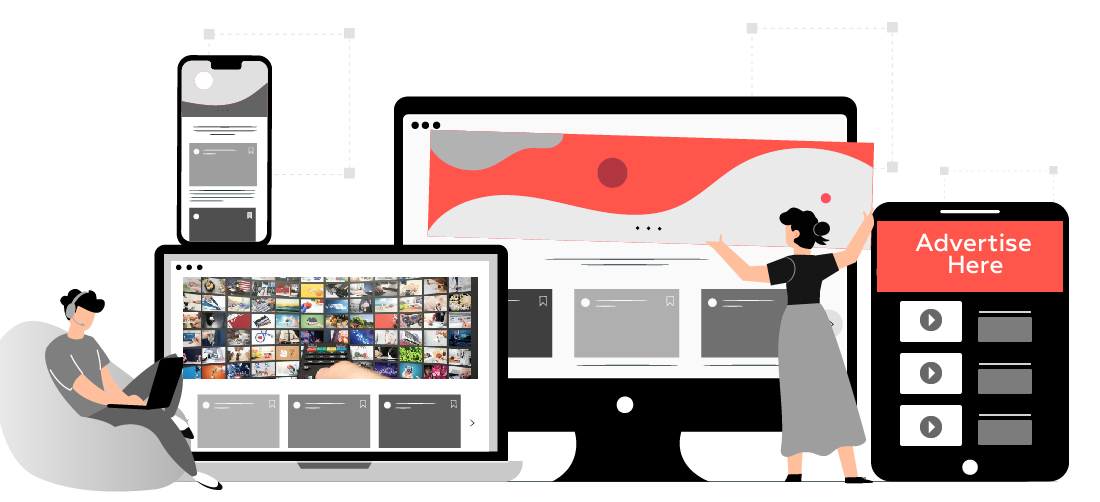Table Of Content
- 1. CTV vs OTT: Understanding the Differences and Their Impact on Advertising
- 2. What is OTT?
- 3. How it Delivers Content?
- 4. Examples of OTT platforms
- 5. What is CTV?
- 6. How Connected TVs Work?
- 7. Typical User Behavior on CTV Platforms
- 8. Differences Between CTV and OTT
- 9. Advertising Opportunities on CTV and OTT
- 10. Why CTV and OTT Are Gaining Popularity?
- 11. Why Marketers Should Care?
- 11.1. Rising Viewership
- 11.2. Targeting Opportunities
- 11.3. Modern Marketing Strategy
- 12. Choosing Between CTV and OTT for Your Campaign
- 12.1. Brand Awareness
- 12.2. Precise Targeting
- 13. Engagement and Interaction
- 14. Conclusion
CTV vs OTT: Understanding the Differences and Their Impact on Advertising
The way we watch media has transformed significantly with digital platforms. Two key players in this shift are Connected TV (CTV) and Over-the-Top (OTT) services, which offer advertisers new ways to connect with audiences. This article will cover the definitions and differences between CTV and OTT, explore advertising opportunities, and discuss why marketers should include them in their strategies.
What is OTT?
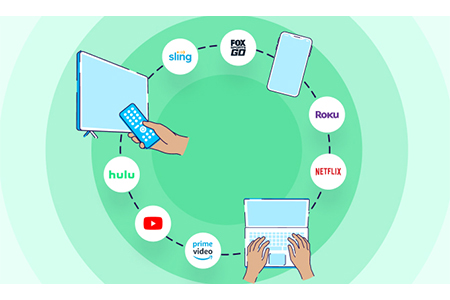
Over-the-top, or OTT, is the process of accessing content directly through the Internet, bypassing traditional cable or satellite television services. Using this kind of service, the same amount of media for movies, TV shows, and live broadcasts can be accessed through the internet alone. Here's a closer look at the concept of OTT:
How it Delivers Content?
Because the OTT content streams online, then a cable or satellite connection is not required. Only an internet connection is necessary for this mode of viewing. This pattern has picked up quickly because of pressures from customers to be more flexible and have a wide range of choices in what they may watch at what time they like.
Examples of OTT platforms
Quite a few popular examples are:
Netflix: A platform that is prominently known for its large library of original content besides movies.
Hulu: Current and classic TV shows alongside original shows.
Prime Video: Exclusives from Amazon: a wide variety of movies and TV shows.
Disney+: Family-friendly content from Disney, Pixar, Marvel, and Star Wars franchises.
HBO Max: HBO as well as WarnerMedia originals and more.
These platforms have revolutionized the way audiences watch media. Such ease with so much choice in what they get to watch.
Availability of a device
The other advantage of OTT is accessibility. One can access content on many devices such as:
Mobile phones: Watch content when out and about
Tablets: Screen size is bigger than mobile phones to watch better
Laptops: Watch series and movies in your house or at work.
Smart TVs: Many smart TVs include built-in apps from popular OTT platforms, thus allowing consumers to directly access content on the big screen.
The flexibility in access to OTT content across multiple devices makes it extremely attractive to consumers seeking a flexible viewing habit.
What is CTV?
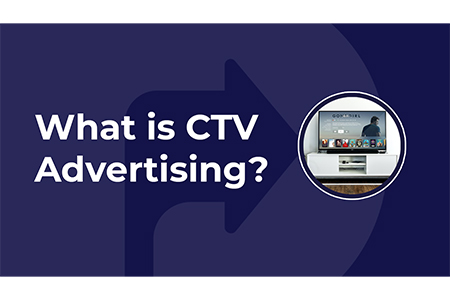
Connected TV is the term used to refer to television that can connect to the internet and stream content from OTT services and other online sources available. Consumers continue to desert traditional cable for CTV, and we should look at the characteristics of this service.
How Connected TVs Work?
Connected TVs make use of the internet so that users can get over-the-top services straight into their televisions. Connecting can be done in many ways:
Built-in Smart TVs: Most of the latest TVs come with streaming and are built with the feature of downloading applications and OTT services.
Streaming Devices: Devices like Roku, Amazon Fire Stick, Apple TV, and Google Chromecast can make a normal TV a smart TV by availing all the streaming services.
Gaming Consoles: Devices like PlayStation and Xbox have streaming capabilities through which content is streamed from various applications.
Typical User Behavior on CTV Platforms
Users interacting with CTV platforms often exhibit distinct behaviors:
- Longer Viewing Sessions: The larger screen size encourages viewers to watch for longer periods, leading to binge-watching habits.
- Engagement with Ads: Viewers are generally more receptive to advertisements on CTV due to the immersive experience of watching on a big screen.
- Content Discovery: CTV platforms often feature personalized recommendations and content discovery tools, enhancing the user experience.
Differences Between CTV and OTT
Although CTV and OTT are closely related concepts, they are not the same. Understanding their differences is crucial for advertisers. Below is a detailed comparison:
|
Feature |
CTV (Connected TV) |
OTT (Over-the-Top) |
|
Definition |
A television connected to the internet, allowing access to streaming content. |
Content delivered directly over the internet, bypassing traditional broadcasting. |
|
Device Examples |
Smart TVs, streaming devices (e.g., Roku, Amazon Fire TV, Apple TV). |
Any internet-enabled device (smartphones, tablets, desktops, CTVs). |
|
Content Access |
Primarily on TV screens through streaming apps. |
Accessible across multiple devices, not limited to TVs. |
|
Interactivity |
Limited to TV interfaces with remotes or voice controls. |
Offers flexible interaction through various device interfaces (touch, keyboard, etc.). |
|
Advertising Targeting |
Highly focused on CTV users, enabling addressable TV ads. |
Broad targeting across multiple devices, enabling wider reach. |
|
Use Cases |
Used for high-quality streaming in a lean-back environment. |
Provides flexibility for users to watch on-the-go or at home. |
|
Examples of Services |
Netflix on Smart TV, Hulu on Roku, Amazon Prime on Fire Stick. |
Netflix on mobile, Hulu on tablet, Amazon Prime on laptop. |
|
Audience Measurement |
Primarily through TV-based analytics and audience data. |
Uses cross-platform analytics to measure engagement across devices. |
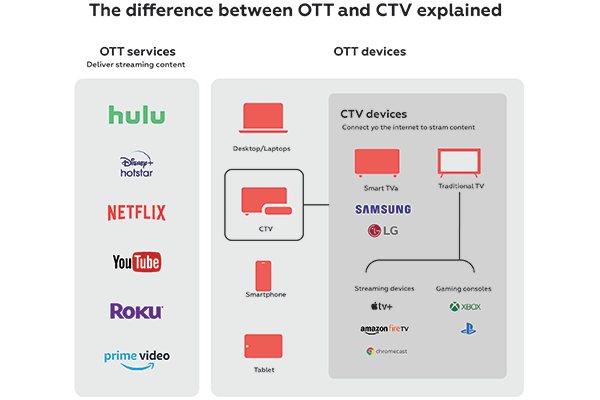
Advertising Opportunities on CTV and OTT

Connected TV, or CTV, and OTT are two recently popular marketing destinations. Such platforms allow a brand to reach viewers through services like streaming; hence it is a newer form of advertising. It is now possible to gain a plain view of what brands use different ad models on CTV and OTT, why they appeal so, and how their success could be measured.
There are many types of ads on CTV and OTT platforms that brands have used to effectively reach their viewers. Some of the key models include:
Pre-roll Ads: These are played before the actual content begins. Pre-rolls are usually shorter. They can be 15–30 seconds long. However, they capture a viewer's attention right at the start. This is why they are great at building brand awareness.
Mid-roll ads: They occur in the content like normal traditional TV commercials tend to catch much more attention because viewers have just received their dose of entertainment so keep watching.
Post-roll: It appears after the actual program is over may not always command much attention because once done with the primary stuff people switch off immediately.
Programmatic Ads: These are automatically placed via technology that seeks the right audience based on data, such as viewer interests or demographics. Programmatic ads can really help brands reach very specific groups without much manual work.
Interactive Ads: Most advertisements on CTV and OTT are interactive where viewers can connect directly with the ads. They can click on an ad to see more information about a product while remaining one of the greatest ways to increase engagement.
Why CTV and OTT Are Gaining Popularity?

CTV and OTT are attractive for marketers because they combine the wide reach of traditional TV with the targeting abilities of digital ads. Unlike standard TV commercials targeted toward broad audiences, CTV and OTT ads can be broadcast to specific groups based on viewer data, such as viewing habits, location, or age. This level of precision helps brands reach the right people without wasting ad spend.
Since people are becoming more and more far-off from cable towards streaming services, it presents a chance for the brands to reach people who otherwise could not have seen their advertisements on traditional cable television. Additionally, because the viewer has control over what they wish to watch on these services, they tend to be more involved with the programming and are hence more likely to see and remember the ad.
Measuring Success on CTV and OTT

Similarly to all other forms of digital commercials, there is a scale for evaluating CTV as well as OTT's performance in relation to several metrics. Among them includes:
Engagement: A measure that assesses what happens in case the viewers interact with the advertisement; higher engagements denote higher involvement on the part of the viewers concerning the offered content or products.
Impressions: It talks about how many times advertisements appear before audiences. The brands take notice of and track these impressions so as to keep in mind numbers concerning viewers getting exposed to its advertisements.
View-Through Rate: This is the number of viewers who actually viewed the whole ad. The view-through rate may be high in case the viewers find it relevant enough or interesting enough to complete viewing.
Why Marketers Should Care?

As CTV and OTT continue to grow, marketers need to prioritize these platforms for their advertising strategies. Here's why:
Rising Viewership
The viewership on CTV and OTT platforms is skyrocketing. More consumers are abandoning traditional cable TV in favor of streaming options. This shift presents a significant opportunity for brands to reach a large and engaged audience.
Targeting Opportunities
CTV and OTT offer advanced targeting capabilities. Advertisers can segment their audience based on any parameter, including:
Demographics: Age, gender, and location.
Interests: Content viewed or preferred.
Behavior: Content viewed or interacted with.
The advanced targeting capability offers an opportunity for advertisers to calibrate the message to be delivered to the right people at the right time.
Modern Marketing Strategy
CTV and OTT are in line with the new behavior of consumers. Here's how these platforms fit into a contemporary marketing approach:
Cross-Device Targeting: CTV and OTT allow advertisers to reach consumers across multiple devices. This flexibility allows for cohesive messaging and brand consistency.
Personalization: The ability to deliver personalized content and ads enhances the user experience, leading to higher engagement and conversion rates.
Adaptability: The nature of media consumption is constantly evolving; therefore, marketing strategies have to be attuned to be inclusive of CTV and OTT to be valid and relevant in business terms.
Choosing Between CTV and OTT for Your Campaign
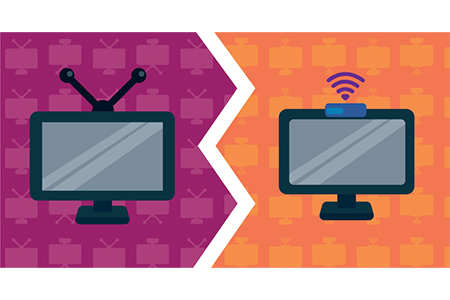
When you have made the decision to create a Connected TV (CTV) versus an Over-The-Top (OTT) advertisement for your campaign, remember that the bottom line in using either one must be in line with your marketing goal. Each system has obvious benefits and can be effective for different strategies.
Brand Awareness
If your goal is brand awareness, then CTV is the best solution for you. Because CTV ads are embedded in popular TV shows, they reach more audiences in a format that is not unfamiliar to people. This could create more visibility and recall if your brand wants to be present or gain a strong foothold in the market. CTV is great with high-quality visuals and great sound. End.
Precise Targeting
One major drawback of precise targeting is that your campaign is more vigorous on OTT than the rest of the options. OTT platforms provide much data analytics that streams content directly over the internet and, therefore allow targeted advertising based on user preferences, behaviors, and demographics. That means you can deliver tailored messages to specific audiences, making your campaigns more efficient and effective.
Engagement and Interaction
Do you want your content to engage your target audience? On the contrary, CTV has a more passive experience of being watched as in traditional advertising. OTT platforms, on the other hand, allow for interactivity in the forms of clickable advertisements and enhanced engaging factors that increase user participation and interest.
Conclusion
This will be critical for marketers seeking to capitalize on this fast-growing digital landscape and to understand the differences between CTV and OTT, which are distinct services offering unique advantages and opportunities for advertisers to reach more engaged audiences.
The shift from traditional TV to digital formats offers a unique opportunity for brands to leverage CTV and OTT to boost awareness and forge stronger connections with consumers. As a leading advertising agency, Excellent Publicity has a specialized team of experts dedicated to aligning your campaign goals with precise audience targeting and budget considerations. We ensure you receive the most informed advertising strategy decisions, maximizing the impact of your brand's digital presence.
Contact us today to learn more about how we can tailor a solution to suit your needs or fill in the form to request a demo of how our services can drive success for your brand.
FAQs
CTV is short for connected television. This is any type of television that has Internet access. OTT means that content is received over the internet and not through any kind of traditional cable or satellite connection. In essence, CTV is device-centric, while OTT is content-centric.
CTV ads are specifically designed for viewing on connected TVs. They often use larger screens and provide interactive features. In contrast, OTT ads can appear on various devices like smartphones and tablets, leading to differences in engagement and targeting.
OTT platforms include services such as Netflix, Hulu, and Amazon Prime Video. This content is delivered directly over the internet. They do not require traditional cable subscriptions. Many ad-supported options.
It is relatively more expensive than OTT ads because of premium placement and larger audiences on connected TVs. However, costs do vary with targeting and platform.
TV is more engaging and targeted because its advertisements can use viewer data for targeted reach. Because of this, the audience will experience a better return on investment and an immersive experience.


